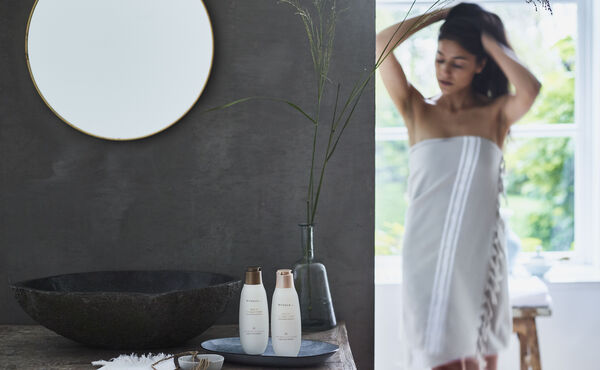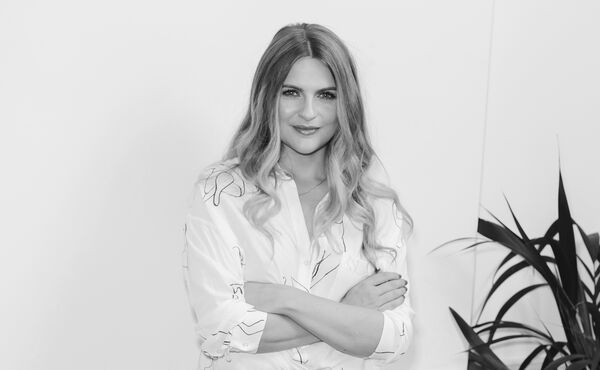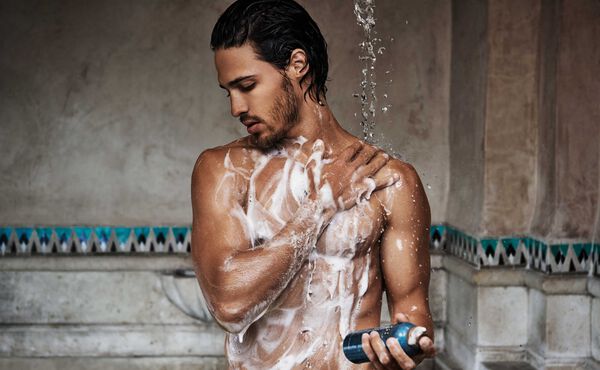Like a small tired child our hair can be incredibly unruly. Without warning it can do the most unexpected things like turn frizzy or go greasy. One moment it can look full of volume, the next as limp as a lettuce leaf. The key to getting the best out of your strands is to identify your hair type and then give it what it needs, from the right routine to the ideal products. We called on 3 hairstylists to share their best hair tips for getting the most out of your strands.
The main hair types
Everyone’s hair is different from the texture and length to the porosity of the strands. But the main types are: thick, fine, straight, curly and afro. Of course, you can have thick or fine straight hair, while curly and afro hair comes in many textures from loose waves to tight coils. If you’re not sure what your type is hairstylist Louis Byrne suggests you, “wash your hair, comb it into the style you want, whether that's a side or middle parting, and then let it dry naturally. Once the hair is dry this will give you a true representation of what hair type you have.”
If you’re really not sure, hairdresser and salon owner Andrew Mulvenna advises you “ask your hairdresser to analyse your hair. Identifying hair types is fundamental in everything we do, so a good hairdresser will be able to tell you.”
The right cut
You can be doing everything right when it comes to treating and styling your particular type of hair, but a good haircut is key. “I would advocate everyone to invest in an amazing haircut, this is the base for everything else,” says hairstylist Tracie Cant.
But there is no one size fits all haircut. “Generally finer hair should be cut more structured, using heavier lines, as this will make it feel thicker and fuller,” explains Byrne. “Whereas thicker hair can take a looser cut.”
If your hair is curly or afro, Byrne warns that your hairdresser shouldn’t be using thinning scissors or razors, “this will only make it frizzy,” and no one wants that!
“Make sure you and your hairdresser understand each other and are speaking the same language,” says Byrne. “Use visual references to help explain what you want and ask your stylist to show you references too,” he adds.
Approach your hair holistically
A good haircare routine isn’t just about the products we apply, “make sure to eat a good diet, organic where possible, and drink plenty of water. We really are what we eat,” says Cant. “Feeling truly beautiful is a much deeper story than simply taking care of the outside, it’s a vibrancy that transcends from deep within. Our hair and skin simply reflect what is being created on the inside.”
Mulvenna agrees, “the secret to great hair is very much like skin. It’s about the balance of hydration inside and out. Get it balanced and your hair will not only behave but be glorious.”
You may wish you had a different hair type but the secret to hair happiness is embracing what you’ve got. Byrne reminds us, “Love your hair for what it is and enhance its natural texture, instead of trying to fight it.”
Feeling truly beautiful is a much deeper story than simply taking care of the outside, it’s a vibrancy that transcends from deep within. Our hair and skin simply reflect what is being created on the inside.
Find your ideal hair routine
Once you’ve identified your hair type styling becomes so much easier! Experts will tell you that the haircare routine starts in the shower with your shampoo and conditioner. In stores Rituals offers a personalisation service where you can choose from two elixirs to personalise your shampoo and conditioner to your hair’s needs, whether that be curl definition, scalp care, volume or gloss or something else entirely. There are 9 elixirs to choose from so you can tweak the formula depending on your hair’s needs. Clever. Hair type identified and shampoo and conditioner sorted, now scroll to your hair type below and discover the haircare routine you need.

-
For thick hair
“Thick hair tends to be more coarse and dense which requires more moisturising and conditioning. Look to slightly heavier, oil-based, products that nourish, hydrate and encourage natural movement and shine,” says Byrne. The Restoring Hair Serum will help keep unwanted frizz and flyaways at bay.
Thick hair doesn’t need to be washed every day; you can simply rinse it through with water in the shower if you feel like it needs a refresh. “After rinsing apply a little ‘leave-in product’ and repeat your drying process as normal. Some people can leave washing their thick hair to just once a week, which is great for making your products last longer. If you can limit washing and leave it to air dry more often, your hair should become healthier and more manageable over time too,” says Mulvenna.
If you in a hurry, use the Refreshing Dry Shampoo to mop up excess oil at the roots and leave hair smelling clean.
-
For fine hair
“Fine hair requires lighter products, avoid anything with oil as this will weigh it down and make it look greasy,” advises Byrne. “Fine hair needs volumising products that are lightweight but lend the hair support and encouragement.”
Mulvenna suggests looking to salt-based products like beach sprays, rather than leave-in conditioners and creams. “These will give the hair more body and fullness and stop an oily root/stringy end situation from happening.” Try the Beach Waves Salt Spray.
If you’re blow-drying your hair, Mulvenna advises using a lightweight conditioner applying it to the ends only, along with a good heat protector all over —the Rituals Protecting Blow Dry Spray will do the trick.
“The main rule with fine hair is not to overload it, less is definitely more,” notes Cant.
-
For curly and afro hair
Curly and afro hair tends to be much drier than other hair types so hydration should be your main focus. Mulvenna suggests that you “wash, condition and then, whilst the hair is still quite damp, almost wet, apply some leave-in conditioner or styling-cream. Comb this through the hair and then, using your hands, gently ‘squeeze’ the lengths to bring out the natural movement and direction. I tend to advise natural drying rather than using a diffuser.”
Byrne recommends you look to “heavier conditioners that are designed to help define the curl and tame frizz.” The Intense Nourishing Oil will keep hair smooth and conditioned—you can use it on damp hair or apply to dry ends to smooth.
Curly and afro hair types require the least washing of all the hair types. If it’s looking frizzy or feeling dry, simply rinse your hair and pack it with leave-in conditioner. Also, be sure to have a mask in your haircare armoury, the Overnight Hydrating Hair Mask means you can nourish your strands while you sleep. Masks and conditioners can be applied from root to tip, just be sure to really rinse the scalp so you don’t leave any product residue there that could irritate.
-
For straight hair
With straight hair Byrne notes that you should be looking to a “good conditioner for smoothness and shine, then styling it based on whether it’s fine or thick.”



.jpg?sw=600&sh=370&sm=fit&cx=2314&cy=0&cw=6487&ch=4000&sfrm=jpg)

